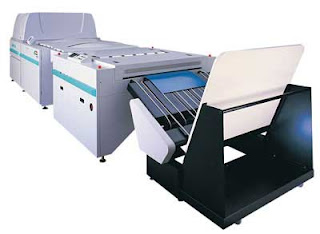 In the Computer-to-Plate or CTP process the image of the page from a digital files recorded directly from the file to the printing plate instead of creating film and making the plate from the film. Although CTP is a printing process, in order to insure the best possible output it is important that the designer discuss CTP with their printer. The printer's familiarity with the process, their equipment, the type of plates, and file format and preparation all play a role in the success of the computer-to-plat
...
Read more »
|
|
Special shades matched against printed specimen or wet sample. |
|
Special shades matched against printed specimen or wet sample. |
|
Special shades matched against printed specimen or wet sample. |
|
Important information for Multi-Unit presses from Pm2:Does this sound familiar?
At one time your press was brand new and printed with the consistent performance and dot value of a new press . . . over the years you observed problems with inconsistent dot value and experienced increased adjustments to achieve consistent dot value. How does this happen? Over time a roller becomes hard, pitted and worn creating hickeys. Eventually the durometer is too high, causing the rubber to shrink unevenly. Consequently, glazing occurs, as a result of excessive leaching of extractable oils. The result is a roller that is about 40 durometer and that will require 10X the amount of mechanical pressure as a 26 durometer to achieve the same stripe setting. With additional M ... Read more » |
|
Special shades matched against printed specimen or wet sample.Matched and Manufactured at our various Mixing & Matching Centres which are equipped with with trained colour matchers and colour matching facilities. ... Read more » |
|
In order to reproduce or prepare a full color image for printing using four process colors, the image must be divided into the the individual subtractive primary color components. The separation process can be accomplished photographically or electronically.
|
|
Here is a list of problems that need to be paid attention to during the process of offset printing:
Uneven colour: Always make sure that the colour is the same on both sides of the sheet by rolling the sheet up so that you can look at opposite edges of the sheet side by side. Ghosts: These are either
Hickies (aka Fish-Eyes): These arenon-inked circles created by lint on the plate or blanket. They are generally something that can be cleaned u
...
Read more »
|
|
Theoretically it is possible to produce an adequate range of colours using just Cyan, Magenta and Yellow. However, three colour printing may also refer to the use of either.
|
|
Four colour process printing is the most common system for producing full colour print. In fact, the vast majority of magazines and colour books are produced using the four-colour process.
Originally the artwork and originals had been separated using filters and four printing plates were produced. The four colour process printing consists of four ink colours namely, Cyan (Blue), Magenta (Red), Yellow and Black and is often referred to as CMYK. The inks used for four colour process printing are translucent due to which they can be overprinted and combined in a variety of differe ... Read more » |